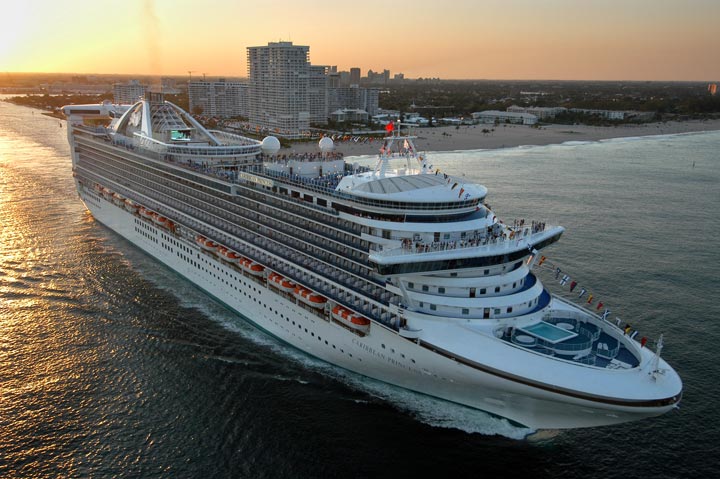TORONTO — It stays alive longer than the flu, it only takes about a handful of virus to get you sick, and once you’re infected, it’ll bring you to your knees (preferably in front of a toilet bowl).

It’s no wonder a little pathogen like norovirus has wreaked havoc on two cruise ships in the past few weeks.
Last week, 600 passengers abroad the Royal Caribbean’s Explorer of the Seas had their vacation cut short after a nasty bout of norovirus crashed the party. U.S. reports peg the outbreak as one of the worst on any cruise ship in the past two decades.
READ MORE: Cruise ship returns to Houston-area port with more than 180 sick passengers
By Friday, the Caribbean Princess, run by Princess Cruises, cut its own seven-day voyage short after almost 200 people became sick with norovirus.
Right now, both ships are being scrubbed down with the help of Centers for Disease Control and Prevention health officials.
And for good reason: norovirus is a mean bug with a handful of very mischievious tricks and once it pops up, it’s often too late to stop the spread.
And its MO? It’s to make you sick — like “you literally turn into an explosion” sick, according to Jason Tetro, a microbiologist and infectious disease expert.
The Canadian author of The Germ Code walks Global News through the ins and outs of norovirus.
It lives longer than the flu, E.coli and other bacteria
Norovirus is a small bug— literally, 27 nanometres or a 27 billionths of a metre. It’s a member of the picornaviruses, which don’t have an envelope.
“They’re just essentially protein and RNA,” Tetro explains.
So what does that mean for us? Most viruses have lipid envelopes, which can work against them. They’re vulnerable to the elements and can die if they don’t infect and attach to something — or someone — soon. The seasonal flu dies in a couple of hours, HIV can die right away and bacterias can take a couple of weeks.
READ MORE: How do you treat the common cold?
Norovirus, on the other hand, can live for months. Yes, that means it could be on a handrail, in a library book, or waiting for you on a doorknob, Tetro says.
It’s a bit of a drama queen
Most infections take between two to 10 days to develop. Norovirus wants you to know it’s got you right away. There is no days long incubation period — we’re talking about six hours until symptoms appear.
If you were on the cruise ship and you caught the bug at breakfast, Tetro is sure you’ll have lost your will to live by dinner.
“As soon as norovirus is inside your body it can multiply so that you go from the one to 10 that went in your mouth to 10 billion per gram of fecal matter in as little as 12 hours,” Tetro explained to Global News.
READ MORE: Fever-reducing pills may help spread flu, Canadian study warns
In layman’s terms, this means a whole lot of pain: severe diarrhea, uncontrollable vomiting (sometimes at the same time), dehydration and weakness, all at varying degrees depending on its victim.
“Although there’s no medical term, it’s essentially a wish to die,” Tetro said.
“You literally turn into an explosion.”
The toilet bowl dependency can last for about 24 to 72 hours. There’s only so many cells the virus likes, and once its infected those, it leaves your system.
Norovirus is a smart cookie: because it comes and goes so fast, it doesn’t give your immune system enough time to process what’s happened. The result? We don’t grow immunity to it.
It only takes a little bit to get you sick, and it likes to linger
So if you’re sick with salmonella poisoning, you probably took in about one hundred thousand bacteria. With norovirus, research suggests you only need between one and 10 to get infected. That’s not a lot of virus at all.
You can breathe in the germs or through consuming food or water contaminated with the bug.
(In one 1999 case, a man vomited in a concert hall. That was enough to infect another 300 people with the airborne virus. Remember that soccer team that was plagued with diarrhea and incessant puking? The culprit was a reusable grocery bag filled with cookies, and they all reached in for a snack.)
READ MORE: Got the flu? Stay home, and bosses don’t ask for sick notes
Once you’ve kicked the awful symptoms, you aren’t home free yet either. With the flu, you typically stop shedding the virus, but with norovirus you could be giving up the virus to others for as long as another 21 days.
Tetro says that’s why hospitals and long-term care residences quickly shut down wards – they’re trying to isolate the virus.
With a combination of needing little to contract the virus, and the virus lingering for as long as it does, it’s no wonder the cruise ships cut their trips short.
“The minute it’s on the cruise ship, you’ve begun the potential for an outbreak,” Tetro said.
“And if you don’t put an end to it, it’s going to continue to spread.”
It’s hard to get rid of
Most of us use antibacterial hand sanitizer religiously, but only for about three to eight seconds. That’s not enough to get rid of this virus.
You need to really wet your hands with this stuff, and scrub for at least 30 seconds to have a fair chance at killing norovirus.
Now imagine a cruise ship: in this case, you need to use a particular disinfectant – like accelerated hydrogen peroxide – and rinse every surface that could be contaminated with the bug.
There are only a handful of germs with that kind of hostility.
carmen.chai@globalnews.ca
Follow @Carmen_Chai




Comments